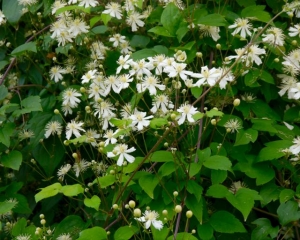Looking up – Scramblers for summer: A plant that can scramble up through another and use it as a support can add another dimension of colour and scent to your garden. Honeysuckle is not small but it is divine. I love its multi coloured trumpet flowers, there is no scent like it, and insects love it. On the downside it has taken a long time to mature and flower regularly in my garden. It also grows like a train, if growing through another plant it needs to be matched with size and vigour. Mine is fighting it out with a holly on one side and viburnum on the other. The happiest solution is to grow it through a native hedge where it can be cut back after flowering.

Honeysuckle
Happy Pairs: clematis can bring really intense colour and a long flowering season. Frequently grown through roses to compliment the colour and cover up the roses’ often poor quality of leaf. Roses too are scramblers, their thorns designed to catch on to the branches of other shrubs and give themselves and leg up. I have a yen to plant a rich red one, like ‘Etoile de Hollande’ or ‘Dans du Feu’ but I will wait until the winter to order some bare-root plants.

Rose ‘Etoile de Hollande’
Bramble Scramble: In the rose family and also scramblers, brambles or black berries can be decorative and of course productive. I am talking about the cultivated sort, not the wild prickly sort. They don’t taste as good fresh as the wild ones, but they cook beautifully, and they look stunning both in flower and in fruit, shinning up through apple trees. They are easy too on a fence or trained on wires, the trick is to cut back the fruiting stems to the ground after fruiting and train in this year’s growth to flower and fruit next year, so they never grow too big for their site.

Blackberries
Keep on Sowing: Sow rocket and mustard salad leaves, radishes and lettuces. Sow parsley for overwintering and sow basil indoors, or buy a supermarket pot and split into four separate plants and pot up.
Summer pruning of apples: Shorten the long whippy shoots back to two or three buds. Summer pruning is really worth doing to encourage fruiting spurs and keeping the tree to a manageable size. It removes leaves that are shading fruit so helps ripening.

Clematis ‘Paul Farges’
Shearing time: The warmth and wet weather has caused masses of lush growth. Paths are covered and smaller plants squashed. Don’t hesitate to cut back all this lush growth, compost it or fill the green bin. It won’t do the plants much harm, early flowerers might well flower again, at the least they will put out a fresh set of leaves by the autumn. Cut back flowering stalks of lavender, but not a serious pruning, keep that for March. Keep the seeds for lavender bags or flavouring lavender sugar.

Lavender flowers/seeds



